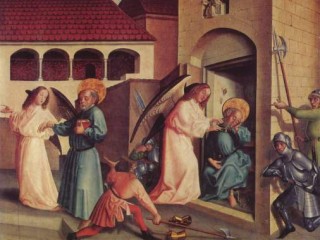
Konrad Witz biography
Date of birth : -
Date of death : -
Birthplace : Rottweil, Black Forest, Germany
Nationality : German
Category : Arts and Entertainment
Last modified : 2011-09-07
Credited as : painter, three-dimensional landscape,
Konrad Witz (ca. 1410-1446) was the first German painter to depict a fully developed three-dimensional space and landscape that is topographically recognizable. His figures have a hieratic monumentality and power.
Konrad Witz was born in the village of Rottweil in the Black Forest. He went to Basel, presumably attracted by the great Church council in progress since 1431. He entered the painters' guild in Basel in 1434. The following year he became a citizen. In 1441-1442 Witz was paid for paintings he executed for the city, and he bought a house in 1443. He died in 1446.
Fate has been unkind to the three major enterprises of Witz, all originally altarpieces composed of many panels, for none is intact today. The earliest certain work is the Mirror of Salvation Altarpiece (ca. 1435), an agglomerate of panels depicting scenes from the Old Testament and Roman history which prefigure man's salvation, for example, the scenes of Antipater before Caesar, the Queen of Sheba before Solomon, and Emperor Augustus and the Tiburtine Sibyl. The lost centerpiece was probably the Birth of Christ, signaling the redemption of man. Witz's last known major work, signed and dated 1444, was the Altarpiece of St. Peter for a chapel in the Cathedral of Geneva. Only the wings, comprising eight scenes, exist today. Probably dating between these two altarpieces, in the artist's creative life-span of a mere 12 years, are three large paintings which may have formed part of an altarpiece of the Virgin. It was originally in the Dominican nunnery in Basel, and the panels are now dispersed.
From beginning to end, Witz's major artistic aim was to present the illusion of plastic form. He achieved this by bright color contrasts, a strong modeling light that causes the simplified figures and objects to cast strong shadows, and the use of stark architectural settings. His figures thus appear like actors on a stage. Stumpy in proportion, with large heads and hands, these figures move awkwardly but convincingly; and to further the illusion Witz imagined such ancient dignitaries as Caesar and Solomon as homely human beings, a sibyl as a robust housewife. The master's conviction of the force of his technique enabled him to transcend his limitations.
Witz's style is memorable because it is born of forthrightness and sincerity. This combination of naivete and sophistication is seen in his most memorable picture, the Miraculous Draught of Fishes, from the St. Peter Altarpiece, wherein the Sea of Galilee becomes a realistically observed portion of Lake Geneva, with the Male mountain in the distance, as it appeared in the artist's own day. As such, the painting is a landmark in the history of Western landscape painting.
















